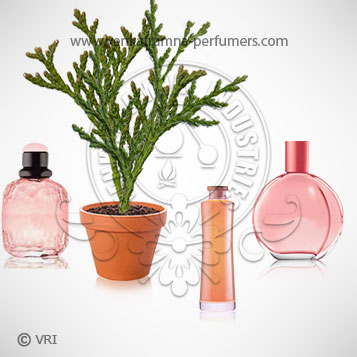
| Botanical Name | Thuja Occidentalis |
| Common Name | Northern white cedar, eastern white cedar, tree of life, American arborvitae, Swamp cedar, white cedar, eastern arborvitae, northern white cedar, eastern white cedar |
| Country of Origin | Canada, France |
| Solubility | Soluble in alcohol |
| Specific Gravity | 0.90000 to 0.91000 @ 25.00 °C. |
| Optical Rotation | -10.56 to -13.80 |
| Refrective Index | 1.44500 to 1.46000 @ 20.00 °C. |
| PlantPart | Leaves, twigs, bark, heartwood. |
| Bland With | Citrus Oils, Lavender, Pine Needle, Armoise, Cedarwood, |
| CAS No | 8007-20-3 |
| Flash Point | 66.67 °C |
| Extraction Method | Steam distilled |
Thuja is a genus of coniferous trees in the Cupressaceae (cypress family). The shoots of trees are usually flat, with side shoots only in a single plane. The leaves have scale shape-like 1–10 mm long, except young seedlings in their first year, which have needle-like leaves. Thuja Oil is believed to have insect repellent, rubefacient, anti rheumatic, astringent, diuretic, emmenagogue, expectorant,stimulant (nerves, uterus and heart muscles), tonic and vermifuge properties. This oil is used in pharmaceutical products because of its therapeutic properties. Apart from this, it also finds usage in toiletries, cosmetics, soaps and detergents perfume due to aromatic properties. Thuja is a genus of coniferous trees in the Cupressaceae (cypress) family. There are five species in the genus, two natives to North America and three native to eastern Asia. The genus is monophyletic and sister to Thujopsis. They are commonly known as arborvitaes (from Latin for tree of life) or Thujas; several species are widely known as cedar but, because they are not true cedars (Cedrus), it has been recommended to call them red-cedars or white-cedars.
Thuja occidentalis, commonly known as Arbor vitae or white cedar, is indigenous to eastern North America and is grown in Europe as an ornamental tree. The plant was first identified as a remedy by native Indians in Canada during a 16th century expedition and was found to prove effective in the treatment of weakness from scurvy. In folk medicine, Thuja occ has been used to treat bronchial catarrh, enuresis, cystitis, psoriasis, uterine carcinomas, amenorrhea and rheumatism. Today, it is mainly used in homeopathy as mother tincture or dilution. In combination with other immunomodulating plants, such as Echinacea purpurea, Echinacea pallida and Baptisia tinctoria, this medicinal plant is also used as evidence-based phytotherapy for acute and chronic infections of the upper respiratory tract, and as an adjuvant to antibiotics in severe bacterial infections such as bronchitis, angina, pharyngitis, otitis media and sinusitis.
Color : Clear yellow to completely colorless & sweet odor,
Aroma : fruity aroma
á-Thujene 0.28, diterpene beyerene, fenchone, bornyl acetate, á-Pinene 1.45, Camphene 2.44, camphor, Sabinene 4.55
Thuja oil is widely used for the treatment of various ailments. It is very productive to the respiratory tract. Its usage also lies in preventing hair loss. In traditional Chinese medicine, the leaves, and stems of Thuja orientalis are used to treat nervous disorders, insomnia, and heart palpitations, as well as to stop hemorrhages and bring down fevers. Traditional Chinese physicians also make a preparation of fresh cedar leaves steeped for seven days in a 60% alcohol solution to promote hair growth. The mixture is rubbed on the bald spots three times daily.